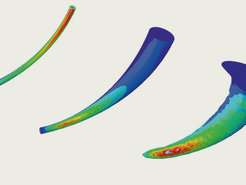An Incisive Bite

The fangs of the large wandering spider (Cupiennius salei) are incisively shaped, right to the tip. The spider uses its curved fang to grasp its prey, puncture its chitinous armor and inject venom into the victim. An Austrian-German research team headed by Yael Politi at the Max Planck Institute of Colloids and Interfaces in Potsdam-Golm established that the shape and structure of the fangs have evolved extremely well to perform their lethal task as reliably as possible over the spiders’ lifetime, and with the minimum amount of damage. For the first time, the researchers analyzed in detail the correlation between the structure and the mechanical properties of the cone-shaped fang and compared it with other potential configurations, such as a needle. The chitin fibers of which the poisonous fangs are essentially made up are arranged in various layers, helping the fang to withstand pressure particularly well when biting. The findings may help improve injection devices used in medicine and technology. (Nature Communications, May 27, 2014)
